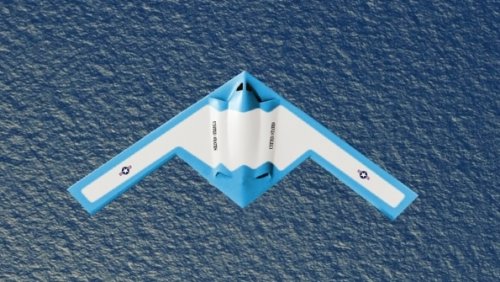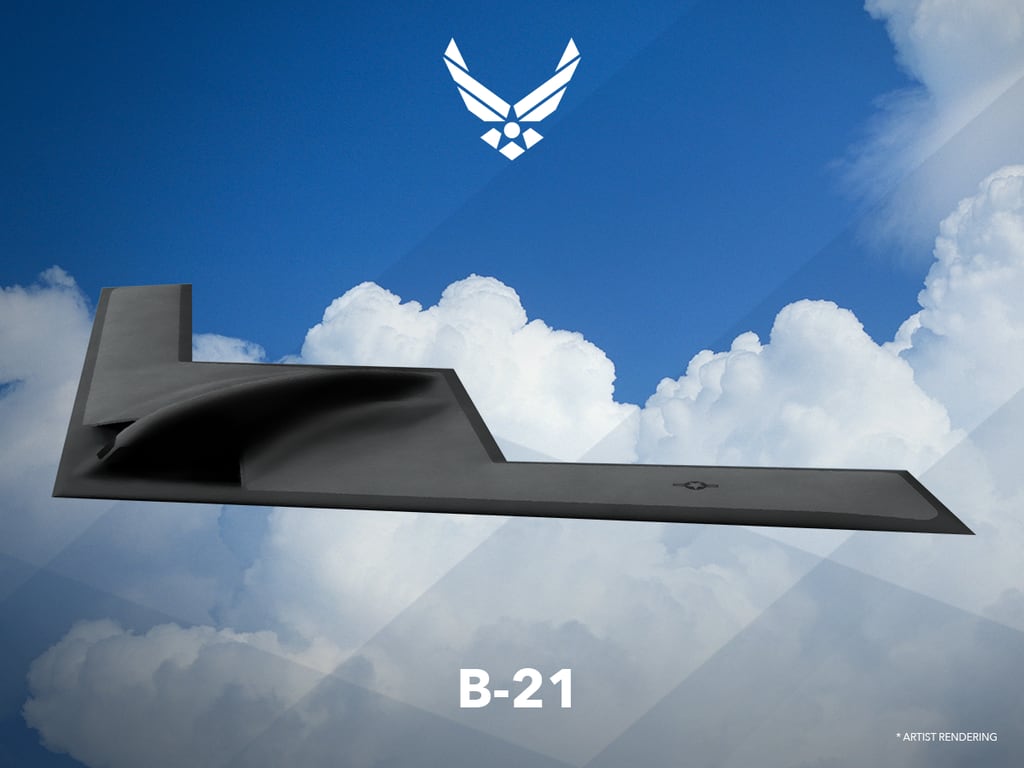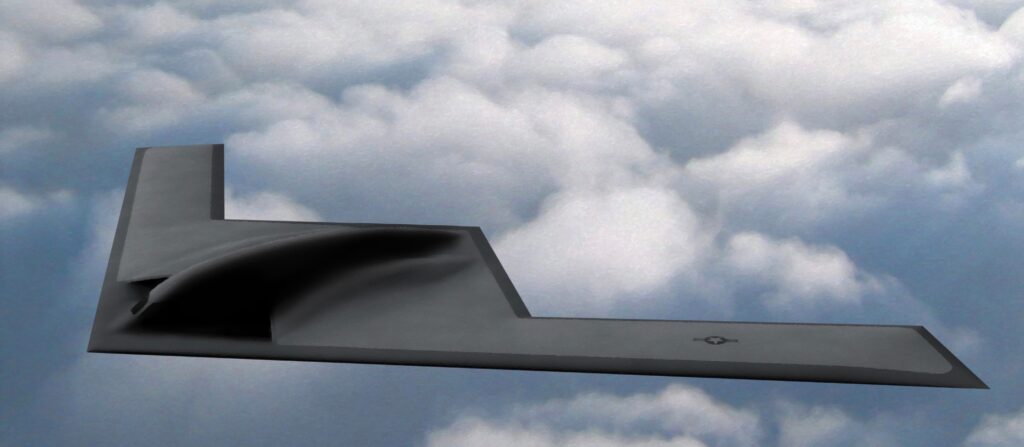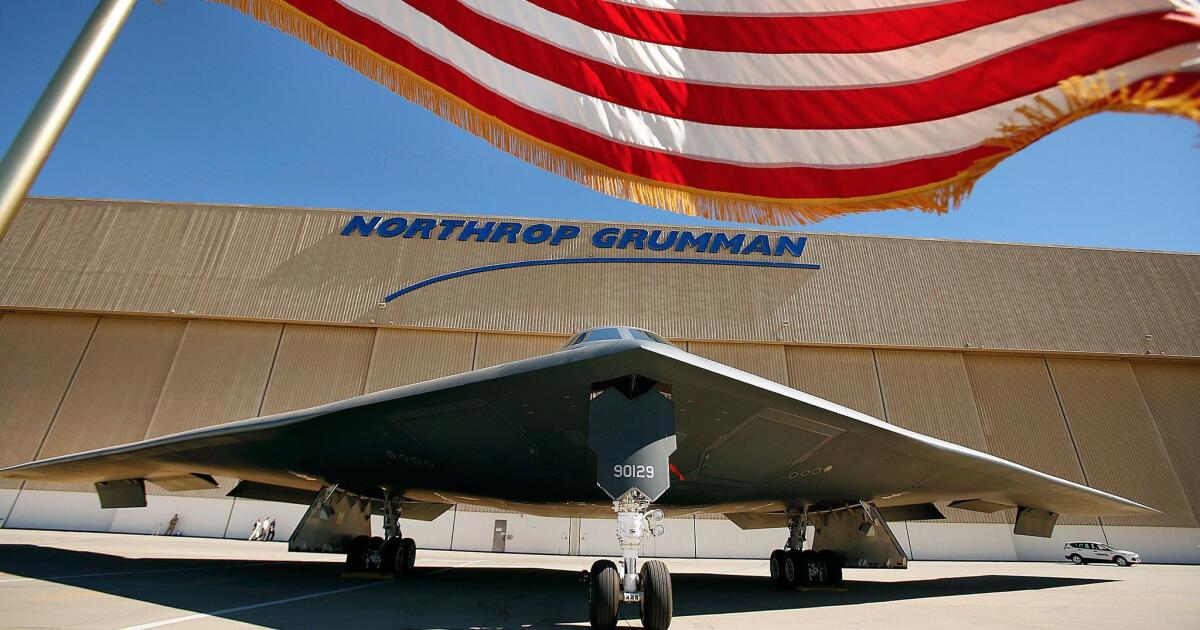Presidential Bomber? Report Touts B-21 For Air Force One
Feb 10, 2017 James Drew | Aerospace Daily & Defense Report
A concept image of the Northrop Grumman B-21 "Presidential Bomber" flying over the Pacific Ocean: James Drew, Aviation Week
A panel of aerospace and defense analysts has proposed ditching the U.S. Air Force’s Boeing 747-8-based Air Force One in favor of the Northrop Grumman B-21 stealth bomber, or a less-costly militarized Boeing 737 fleet.
The group, writing for Wright Williams & Kelly (WWK), a cost management software and consulting company, says in a new report that President Donald Trump’s concerns about the massive cost of modifying two or three end-of-the-line 747-8 commercial airliners into military-grade presidential transports could be significantly reduced by recasting the requirements, which demand four engines and accommodations for an entourage of 70-plus passengers. By taking into account the safety and reliability of modern twin-engine aircraft, the Air Force would have a wide range of alternatives to study, instead of being limited to the Boeing 747-8 or Airbus A380.
In December, Trump blasted the Presidential Aircraft Recapitalization (PAR) program because of its estimated $3.2 billion price tag in a tweet, saying costs were “out of control.” Defense Secretary James Mattis has since ordered a full review of the project and its requirements to find cost savings. The Pentagon’s second look centers on specifications for autonomous operations, aircraft power generation, environmental conditioning, survivability and military and civilian communications capabilities. But what about switching airframes?
Danny Lam, who contributed to the WWK report and is a spokesman on behalf of the group, says the report focused on the B-21 and 737. It does not rule out the Boeing 767, nor foreign airframes built by Airbus, Bombardier or Embraer. Russian and Chinese alternatives were not candidates.
The penny-wise option is a fleet of presidential 737s, since the type has already been adapted for military use at great expense. The 737-700-based C-40 already carries passengers for the U.S. Navy and U.S. Air Force. The 737 has also been converted into the P-8A Poseidon submarine hunter for the Navy, Australia, India, Norway and the UK. It is the basis for Australia, South Korea, and Turkey’s airborne early warning and control aircraft. Boeing has also pitched it as a replacement for the Air Force’s E-8C Joint Surveillance Target Attack Radar System, EC-130H Compass Call and RC-135 Rivet Joint aircraft.
The CFM56-7B-powered C-40B/C version operated by the Air Force carries 26-32 or 42-111 passengers, depending on the configuration. It has an unrefueled range of 4,500-5,000 nm. It could hop from Joint Base Andrews in Maryland to France, Germany, the UK, South America and North Africa. With a pit-stop at Travis AFB, California, it could reach Hawaii or potentially Japan unrefueled. The P-8A, based on the reinforced 737-800ERX airframe, has less range when fully armed and loaded, but comes equipped with aerial refueling and is practically bristling with military-grade radio antennas and datalinks, many of the same items the 747-8 needs to serve as Air Force One.
“All the things the 747 will need, it’s already been done on the 737,” Lam says. The one-time expense of militarizing the 747 would be wasted on an aircraft that is likely to go out of production because of low sales, he adds. “A 737-based aircraft would probably meet most of their needs and it’ll be cheaper. We’re still going to be flying 737s for at least 30 years down the road.”
The 737 is Boeing’s smallest commercial aircraft, and can access more airports and shorter runways than the hulking 747-8. Many of the same modifications needed to carry the president would be inherent in a future flying command post to replace the Navy Boeing E-6 Mercury, which can launch intercontinental ballistic missiles in the outbreak of a nuclear war. Allies such as Australia, Canada, Germany, Japan and the UK might also want to adopt the type.
Lam says the larger 767-2C, the basis for the Air Force’s new KC-46 Pegasus tanker, could also fit the bill and deserves more analysis. “But it’s the 737’s to lose if we were to go to a civilian aircraft,” he says.
Central to the B-21 proposal is safety. Lan says the proliferation of high-tech surface-to-air missiles to “non-state actors and guerrilla groups” is a significant threat to Air Force One, and a 747-8 is particularly vulnerable.
“The 747 is a fat radar target, about the size of a B-52,” he says. “[The B-21] has stealth built in, it’s nuclear-rated and heavily shielded right off the bat. It’s going to be terribly cramped but man, it would be a survivable platform, especially if operated in twos and threes.”
The exact details of the aircraft are classified, but development started early last year after years of extensive prototyping. Initial deployment is expected in the mid-2020s. The 747-8 is due to replace the Boeing 747-200B-based VC-25 Air Force One fleet “in the 2024 time frame,” the service says.
The report’s analysis of a presidential bomber is based on the unclassified Northrop B-2 Spirit. Lam says the bomber’s internal weapons bay and other compartments could be stripped out and modified to carry a handful of people. The B-21 will almost certainly carry the 20-ft.-long, 30,000-lb. Boeing Massive Ordnance Penetrator, allowing for some estimation of the size available.
Because of their reduced passenger capacity, the 737 and B-21 options would require additional aircraft to carry government and military support staff as well as members of the press. Non-essential personnel would keep some distance from the main presidential aircraft for safety and communicate via directional, encrypted datalink.
Heavy cargo, such as the presidential helicopter and bulletproof limousine, are already hauled separately by military cargo aircraft, specifically the Boeing C-17 Globemaster, Lockheed Martin C-5 Galaxy and C-130 Hercules. Inflight refueling will be provided by the Boeing KC-135 Stratotanker, KC-10 Extender and KC-46.
In terms of U.S. prestige, Lam says the 747 “Jumbo Jet” does not wow crowds like it did when introduced in the 1970s and could soon be extinct, anyway, along with the Airbus A380 “Superjumbo.” The twin VC-25s are the only two passenger-carrying 747-200s still in active service in the U.S. Lam suggested that those existing aircraft be retained as a backup, or for the times that the president wants to make an intercontinental-range trip along a secure flightpath, or to Beijing and Moscow—places where the government does not want to park its most technologically advanced stealth aircraft.
“What image do you want to project? An aircraft that’s going out of production? Or that you’re dealing with a nation that is deadly serious about going to war if you’re not careful,” he says. “Is that the image we want to project? That’s a policy decision. But suppose you’re a little power who wants to take out the president of the U.S. with a surprise attack. I would say the deterrent effect of showing up in a very, very well-protected, heavily-armed aircraft with multiple planes—I’d think twice.”
Air Force Once is operated by the 89th Airlift Wing from Joint Base Andrews. Short-range helicopter flights are provided by Marine Helicopter Squadron One (HMX-1), which operates the Sikorsky VH-3D, VH-60N, Bell-Boeing MV-22B and eventually the VH-92A out of Quantico, Virginia.
The 1980s-vintage VC-25 aircraft will exceed their planned 30-year service life this year, the service says. The service describes presidential airlift as a “no-fail” mission, requiring accommodations for the president to fulfill his or her constitutional duties as commander of the armed forces, head of state and chief executive “worldwide, while airborne.” The aircraft must be capable of operating during a nuclear war, and is hardened against electromagnetic pulses and other interference. An initial set of requirements were released in September 2013 and 21 companies attended an industry day that December. The choice came down to Boeing or Airbus, but Airbus only wanted to provide the aircraft, not compete as a prime contractor. The Air Force went ahead with the 747-8 option in 2015 and released a single-source request for proposals to Boeing late last year. The service has already awarded Boeing more than $170 million for risk-reduction activities, and was due to buy the first early aircraft this year. That award is still pending.
Trump is no stranger to executive travel. The billionaire real estate magnate’s custom-tailored Boeing 757-200, known as “Trump Force One,” featured prominently in the campaign leading up to the November presidential election. The U.S. is also familiar with “Shepherd One,” the unofficial title given to the Pope’s Alitalia-operated Airbus A321 papal airlifter. The aircraft was in Washington in September 2015.
The president of Mexico flies in a specialized Boeing 787-8 Dreamliner operated by the Mexican air force. Australian prime ministers once shuttled around in a leased Boeing Business Jet, but now ride on the Royal Australian Air Force’s Airbus KC-30A Multi-Role Tanker Transport.





